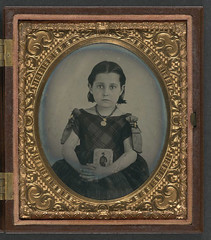Difference between revisions of "Ambrotype"
m (fixed two broken img, +headers) |
|||
| Line 1: | Line 1: | ||
{|class=plainlinks | {|class=plainlinks | ||
||[http://www.flickr.com/photos/library_of_congress/3252917783/ http://farm4.static.flickr.com/3093/3252917783_e81308e684_m.jpg] | ||[http://www.flickr.com/photos/library_of_congress/3252917783/ http://farm4.static.flickr.com/3093/3252917783_e81308e684_m.jpg] | ||
| − | ||[http://www.flickr.com/photos/library_of_congress/5228576175/ http://farm6. | + | ||[http://www.flickr.com/photos/library_of_congress/5228576175/ http://farm6.staticflickr.com/5085/5228576175_a999bdab81_m.jpg] |
| − | ||[http://www.flickr.com/photos/library_of_congress/5229146672/ http://farm6. | + | ||[http://www.flickr.com/photos/library_of_congress/5229146672/ http://farm6.staticflickr.com/5050/5229146672_e827d2f703_m.jpg] |
|- | |- | ||
|colspan=3|Abraham Lincoln, Union soldier, girl with image of her father, images: Library of Congress {{public domain}} | |colspan=3|Abraham Lincoln, Union soldier, girl with image of her father, images: Library of Congress {{public domain}} | ||
| Line 14: | Line 14: | ||
Ambrotypes were often hand-tinted to increase the contrast; without this, Ambrotypes are grayish-white and compare poorly to [[Daguerreotype Process|Daguerreotypes]]. | Ambrotypes were often hand-tinted to increase the contrast; without this, Ambrotypes are grayish-white and compare poorly to [[Daguerreotype Process|Daguerreotypes]]. | ||
| + | ==Notes== | ||
<references /> | <references /> | ||
| + | ==Links== | ||
* [http://en.wikipedia.org/wiki/Ambrotype Wikipedia: Ambrotype] - apparently wrongly attributes the invention to Cutting, [http://www.google.com/patents?id=9wcdAAAAEBAJ&printsec=abstract&zoom=4&dq=ambrotype+1854 whose patent] only mentions the varnish or balsam back coating. | * [http://en.wikipedia.org/wiki/Ambrotype Wikipedia: Ambrotype] - apparently wrongly attributes the invention to Cutting, [http://www.google.com/patents?id=9wcdAAAAEBAJ&printsec=abstract&zoom=4&dq=ambrotype+1854 whose patent] only mentions the varnish or balsam back coating. | ||
[[Category: Photographic processes]] | [[Category: Photographic processes]] | ||
Revision as of 15:57, 30 March 2012

|

|

|
| Abraham Lincoln, Union soldier, girl with image of her father, images: Library of Congress (Image rights) | ||
Ambrotype is a photographic process resulting in positives on glass, originated by Frederick Scott Archer and Peter W Fry in 1851[1]. It was intended as a cheaper alternative to the Daguerreotype. It is based on the wet-collodion process. It was also known, in Britain, as "collodion positive", and in other places as "Melainotype".
Glass plates are prepared, and developed as in the wet-collodion process, but underexposed. This gives a less dark glass negative. The negative is treated with mercuric bichloride to whiten the exposed areas. The plate is mounted in a metal frame with a black background. The background makes the negative appear positive - as the whitened silvered areas reflect light, and the transparent areas show the black background.
The back was sometimes varnished or coated with balsam to improve the image; James Ambrose Cutting of Boston was granted a US patent in 1854[2] on a method of doing this - which makes the image "greatly increased in strength and beauty by imparting additional brilliancy".
Ambrotypes were often hand-tinted to increase the contrast; without this, Ambrotypes are grayish-white and compare poorly to Daguerreotypes.
Notes
- ↑ Focal Encyclopedia of Photography, Focal Press, 1976 edition, p.40
- ↑ US Patent 11,267: Improvement in Photographic Pictures on Glass
Links
- Wikipedia: Ambrotype - apparently wrongly attributes the invention to Cutting, whose patent only mentions the varnish or balsam back coating.